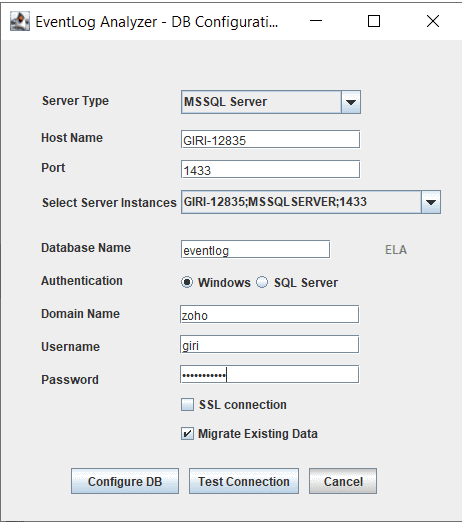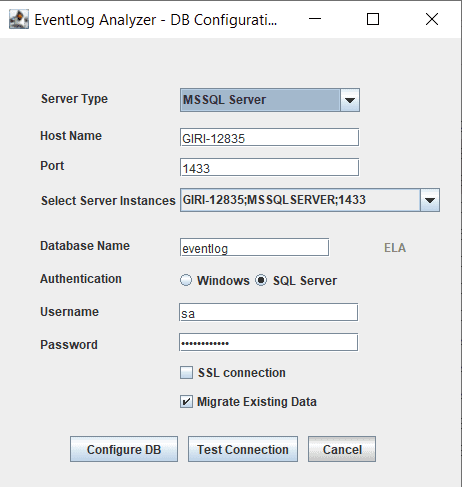- Related Products
- Log360
- AD360
- ADManager Plus
- ADAudit Plus
- ADSelfService Plus
- Exchange Reporter Plus
 Click here to expand
Click here to expand
This page describes the various steps involved in configuring the MS SQL database in EventLog Analyzer.
This procedure to configure MS SQL will clear all existing data.
Before making changes to the database with the changeDBServer.bat file, it's crucial to ensure that the product is fully operational. Once confirmed, proceed to shut down the product. Once the product has successfully stopped, run the changeDBServer.bat file.
Here's how you can configure and run the EventLog Analyzer with MS SQL as the database.
For MSSQL version 2012, install the native client and for the remaining versions of MSSQL, install the ODBC driver (links given below).
MSSQL 2012
https://www.microsoft.com/en-us/download/confirmation.aspx?id=50402
MSSQL 2014
https://www.microsoft.com/en-us/download/details.aspx?id=36434
MSSQL 2016
https://www.microsoft.com/en-us/download/details.aspx?id=50420
MSSQL 2017
https://www.microsoft.com/en-us/download/details.aspx?id=53339
MSSQL 2019
64bit link: https://go.microsoft.com/fwlink/?linkid=2137027
32bit link: https://go.microsoft.com/fwlink/?linkid=2137028
MSSQL 2022
64bit link: https://go.microsoft.com/fwlink/?linkid=2249006
32bit link: https://go.microsoft.com/fwlink/?linkid=2249005
After installing the required Native client/ODBC Driver, you can check if you've got the right version of bcp.exe+bcp.rll files or the right version of the Native client/ODBC Driver by going to <EventLog Analyzer Home>\bin folder, opening the command prompt with admin rights and executing the following command:-
bcp.exe -v
If you get an error, either your bcp files are wrong or your Native Client/ODBC Driver version in the EventLog Analyzer machine is incorrect.

For SQL Server Authentication, enter the User Name and Password.

| S. no. | Start-up Type | Required Permission(s) for Login | Comments |
| 1 | (First start) |
|
|
| 2 | Warm Start |
GRANT CONTROL ON SYMMETRIC KEY::[##MS_DatabaseMasterKey##] TO [user]; -- if not provided, user will not know if a master key exists in DB GRANT CONTROL ON SYMMETRIC KEY::[ZOHO_SYMM_KEY] TO [user]; GRANT CONTROL ON CERTIFICATE::[ZOHO_CERT] TO [user]; |
|
If you are already using the EventLog Analyzer with PGSQL or MySQL and you want to change the database to MS SQL, please refer the Migrating EventLog Analyzer Data from PGSQL to MS SQL Database page or Migrating EventLog Analyzer Data from MySQL to MS SQL Database page respectively and follow the procedure given there.
Copyright © 2020, ZOHO Corp. All Rights Reserved.